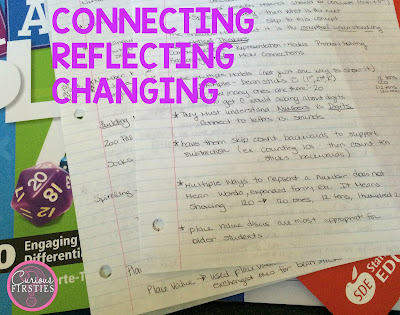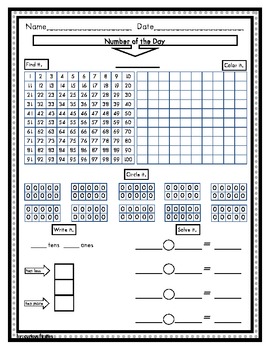Thursday and Friday were both spent at the Ohio I Can Teach Math conference alongside my teacher partner, Jess. There were four presenters that shared their knowledge on numbers sense, part-part-whole, assessments, and math in the real world. It matched up pretty well with our math philosophy and we found ourselves nodding to most of the things being said. And quite honestly, we were already implementing most of the ideas that were presented. But even with this being true, there is always room to tweak, change, and grow in areas that may already be familiar.
So, of course, I started connecting, reflecting, and making my list of changes right away. This is great place for me to share and ask for feedback on these new goals. So I am going to share what we currently do and how we are going to change/tweak it based on our new learning.
First of all, a big theme throughout the conference was that we are working towards conceptual understanding as math teacher because that is what encourages mathematical thinkers. One quote that really stuck out to me concerning this:
CURRENTLY DO:
Place value was a big topic discussed. This included place value strips, bean sticks, place value blocks, and discs. It was recommended that at the first grade level students make the bean sticks themselves so that they can see what a group of ten is composed of. Many times place value blocks can still be a bit abstract for this age.
I love this! We do make bean sticks already in our classroom for this exact reason.
CHANGES TO MAKE:
Although our students make these bean sticks and we use them for some +/- tens games, we don't use them enough. So one of our goals is to use these materials more often. Here is an example:
Our next story problem theme is "Teddy Bear Store." We are going to make crates of teddy bears to represent groups of 10. We will still do this because it is great manipulative and makes it more real life-ish; however, Jess and I have decided to transition over to the bean sticks so that students can make the connection and see a group of ten is a couple of different ways.
CURRENTLY DO:
Another topic that was discussed is the importance of students representing a number in multiple ways. Yes, yes...we do this. Our "number of the day" sheet covers this pretty well. They represent a number with a hundreds chart, ten frames, equations, etc.
CHANGES TO MAKE:
But I quickly learned that representing a number in multiple ways means so much more. It means to have a deep understanding of how a number can be composed of different parts (part part whole). For example: a student should understand that 35 is the same as 20 and 15.
Okay...I discuss this with them all the time when we break a number into parts. But I really believe that I could phrase it differently to support their understanding even more. In turn, this is going to help them when they begin regrouping when subtracting.
So instead of saying "3 and 5 make 8," I want to add in questions like: Is 3 and 5 the same as 8? or "Are 12 tens the same as 1 hundred and 2 tens?" Being more purposeful and intentional with my questioning could make a world of difference when it comes to decomposing numbers.
CURRENTLY DO:
Math Talks were discussed in quite a few sessions that I attended. The book Math Talk by Char Forsten and Torri Richards was displayed and demonstrated. By displaying the pictures from the book, students are asked to tell what they see. Through these conversations, different math concepts can be taught, part part whole thinking can be encouraged, and math language can be developed.
We have been using Number Talks to support this language, modeling, and mental math development and we will continue to do so.
CHANGES TO MAKE:
We do not want to replace our Number Talk routines with Math Talk images; however, we think that using more real world images could be a great tool to support some our guided math routines.
One example that was shown was the use of a family picture. Students could discuss the members of their family through number bond expressions. YES! I love this idea for the beginning of first grade (I want to add this). Here is my example:
Three people in my family are girls and one is a boy (3 + 1 = 4). Two people in my family are adults and two are children (2 + 2 = 4). Four people in my family have blue eyes (4 + 0 = 4).
Another example given was to use pictures of things from our house, places you go, or illustrations from books/magazines. This got us thinking...we are about to start a unit on missing addend. Jess and I decided to use this new idea to support missing addend.
Using this picture above of my girls collecting buckeyes from our tree, I can say: "Gertie is holding 4 buckeyes but she found 11. How many buckeyes was she not able to fit into her hand?"
It pulls in the real world application of missing addend.
CURRENTLY DO:
Number bracelets. Love them to support part part whole thinking. We use them each day as students continue to work on learning their number bonds.
CHANGES TO MAKE:
But...I made all of our number bracelets and I used whatever colors I had. The suggestion was made that students in kindergarten make number bracelets 0-10 and first graders make 11-20. These bracelets stay with them through second grade. Then they can be taken apart and reused in kindergarten.
When making the bracelets certain colors should be used for each number. This allows the teacher to look out and know immediately that students are using the correct number bracelet. Brilliant!! Why didn't I think of this organizational tool?
A FEW MORE CHANGES:
As I reflected on my learning, there are a few other minor things I want to work on as a educator.
1. Helping students understand that subtraction is the difference or distance between numbers.
2. When working on story problems (or math stories) I want to ask, "Are we looking for a part or a whole?"
3. When teaching subtraction, I want to turn away from saying "start with the bigger number" to "start with the whole number."
So what are your thoughts? Is there anything here that you would like to change? Or any suggestions that you have for me?









I always learn a lot when I open up a post from you! Thanks for more info. Hope you have a great week!
ReplyDeleteAlyce
Sounds like a very meaningful conference. Wish I could have come along for the ride! There's a lot here to digest, but I especially like using real world images.
ReplyDeleteNow I see why you are such a wonderful teacher. We never stop learning and changing, do we? Thank you for bringing us along. I will incorporate many of the changes you made into my own number corner. Great suggestions!!! Julie
ReplyDeleteThis is such a wonderful post. I really love how you reflected on specific language (especially since you are already doing so many of these things!). You make me want to teach math again!
ReplyDelete